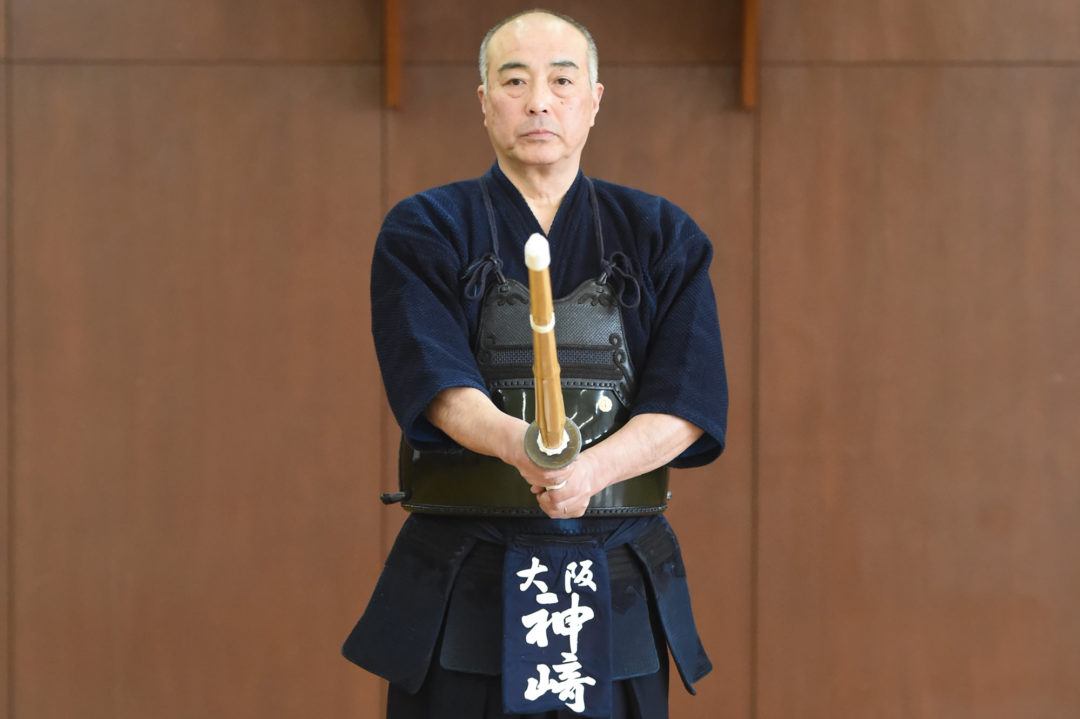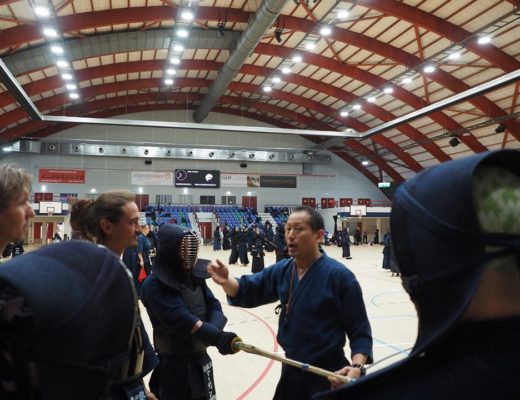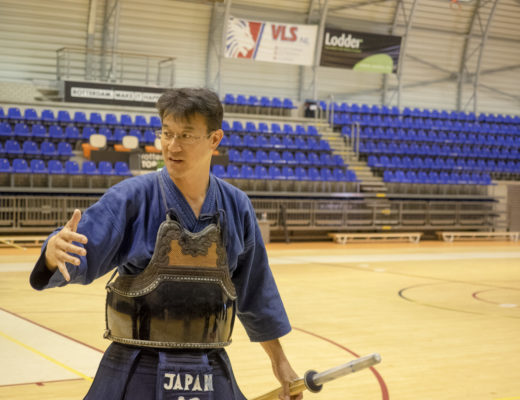2019.5 KENDOJIDAI
“I think any Kendoka should aim for unity of offense and defense” says Kanzaki Hiroshi, who focuses on his Kamae to put this into practice. By reflecting on your Kamae, you will be able to attain correct Kendo and it will last a lifetime. Kanzaki Sensei laid out the the importance of Kamae for us.
profile
Kanzaki Hiroshi, Kyoshi 8th Dan
Born in Miyazaki prefecture in 1960. Moved from Nobeoka High School to the University of Tsukuba and Tsukuba Graduate School, then went on to teach at Osaka University of Health and Sport Sciences. Participated in All-Japan Championships, won the National Teachers Team Championship, competed in the All Japan Prefectural Championship, took 3rd place at the All Japan 7th Dan Championship, competed in the All-Japan East-West Tournament and participated in All-Japan Invitational 8th dan Championship, etc. Currently a professor at Osaka University of Health and Sport Sciences and general director of the Kendo Club.
Aim for unity of offense and defense
Kamae is foundational
It is often said that Kamae is important in Kendo. But how many people can give a good answer when asked why Kamae is important? If you look at challenges that have become a hot topic these days, Kendo which initiates from a disturbed posture is the subject of criticism. It is a fact that many practitioners do not like Kendo that begins from defense. Therefore, I think that every individual in modern Kendo needs to reflect on their Kamae.
I think one’s Kamae is a manifestation of their sense of Kendo.
Each person has their own characteristics, such as their footwork, grip of the Shinai, posture and Metsuke (gaze). There is a unified view in Kendo on what Kamae should be like. However, I think there is some room for further thought about why that view exists. In Kenjutsu, which can be said to be the ancestor of Kendo, there are schools where Hanmi no Kamae and Hitomie no Kamae are commonplace. If we consider modern Kendo as one of those schools, it is currently being practised as face-to-face fight. I think that when fighting in this style, the meaning of our Kamae is very important.
Kamae includes Migamae (Kamae of the body), Kigamae (mental Kamae) and Kokorogamae (Kamae of the spirit). The offense and defense as part of a duel must be included in Kamae. This is what we call Kōbō Icchi (the unity of offense and defense). The word Kōbō Itchi sounds very simple in words, but in order to achieve this it is essential you have a rich Kamae. The Seme in Kendo comes from the movement of the Kensaki and body. I think most people who do Kendo can relate to the idea that the root for this lies in the Kamae. Or, you may have had the experience that if your Kamae is rich, your opponent strikes at you it will not result in an Ippon.
I will return to the beginning of the story but I must say that modern Kendo, which ought to aim for Kōbō Icchi is being criticized for not putting enough emphasis on it. There are certain requirements for an Ippon as described by the All Japan Kendo Federation. Is it possible to perform techniques and fulfil these requirements with Kendo that starts from defense? I think that the person practising Kendo understands best whether or not the criteria of proper posture and correct blade angles are satisfied.
I think that if you pursue the question of what correct Kendo is, you must reflect on your Kamae. As mentioned above, Kendo always contains offense and defense and there is no way to do only one of them. In the first place, the best Ippon is performed from an undisturbed Kamae and leads to a secure defense. If these values are shared by all Kendo practitioners, there should be fewer cases where people disrupt their Kamae to defend themselves.
“Prepare yourself, prepare your mind”
Everything is interlinked
The Migamae, Kigamae and Kokorogamae are not independent of each other and must be linked.
The Migamae can be rephrased as the “style of Kamae” but what matters is whether it allows you to perform at your best. Naturally, we all have different physiques and in a competitive environment like Kendo where we use equipment, the techniques we utilize will also vary greatly depending on the level of training. Each person’s techniques are also different in relation to these areas. There is a basic Kamae with certain requirements, but beyond that it is necessary for each individual to learn what suits them and make it their own.
One of the teachers I received guidance from that I found particularly wonderful in terms of Kamae, is Professor Komorizono Masao (Hanshi 9th Dan). I have done Keiko many times with Komorizono Sensei Shudokan in Osaka since he left the International Budo University. The line from his shoulder to his left hand when Sensei took Kamae is something which I can talk about with the older Senpai in Osaka even now. It was very controlled, and the strength of the Kensaki that came from this Kamae was remarkable. Professor Sakudo Masao (Hanshi 8th Dan), who has been instructing at Osaka University of Health and Sport Sciences for many years also had a Kamae with a unique sense of overwhelming intimidation.
With Kamae, it is difficult to describe what is brilliant about it. However, it can be said that what makes it difficult to describe is exactly its essence. When Migamae, Kigamae and Kokorogamae are put into one form, you can see things that are difficult to express into words, something like intimidation or aura. In the process of Kendo training, I feel it is necessary to pursue the elements of Kamae in search of this unobservable ingredient.
Kigamae and Kokorogamae are also unobservable. I think these are the mental parts of Kamae such as your Seme or readiness to respond. However, this cannot be activated without the Migamae. So they are not independent of each other, but linked.
Standard Kendo is essential for practicing lifelong Kendo
I think that the Kamae is different depending on the instructor, the level of one’s Kendo and age. When I was younger, I too had wide legs and a posture where winning Shiai was my first priority. After entering the University of Tsukuba, I aimed to become a Kendo instructor and corrected myself to the so-called standard Kamae. During this correction I couldn’t do the things I used to be able to do or win Shiai, but when humans try new things and are put in that kind of situation, they get through it somehow. In this way, new styles are created and I feel that this was a valuable experience.
To avoid misunderstandings, I would like to add just because it’s standard Kendo it doesn’t mean that it’s weak. Rather, the standard Kendo is what we should be looking for the most in a lifelong practice of Kendo. When you’re young, even if your Kamae is out of balance you can make up for it in other areas. However, this is not the case as we age. When you can no longer compensate, it’s the basics you need to return to.
There are many things that come to light as you accumulate your training, deepening your understanding of Kihon.What I want you to keep in mind when you study Kendo from now on, is what happens to your Kamae when you feel Kyōkugiwaku (4 states of anxiety: surprise, fear, doubt, and confusion) during interaction with your opponent. The moment these four states also known as “Shikai” occur, do you easily raise your hands because you sense danger, or do you stay patient, hold back and turn to attacking without losing your posture? The aforementioned Sensei did not flinch at such moments, and even if we wanted to attack them, they were emanating something with their Kamae so that we could not strike them. I feel that this difference is the most important part of the Kamae.
The rest of this article is only available for Kendo Jidai International subscribers!





